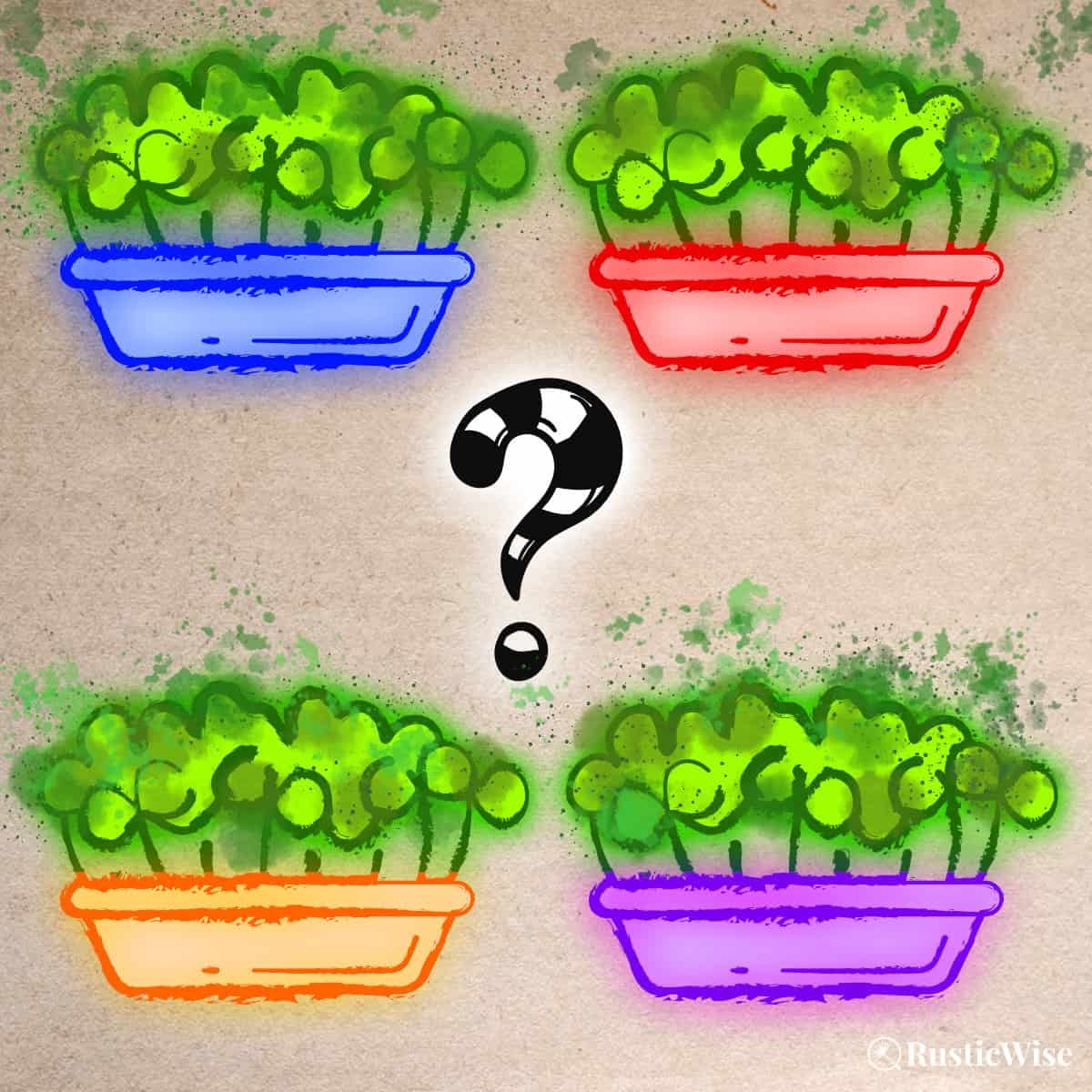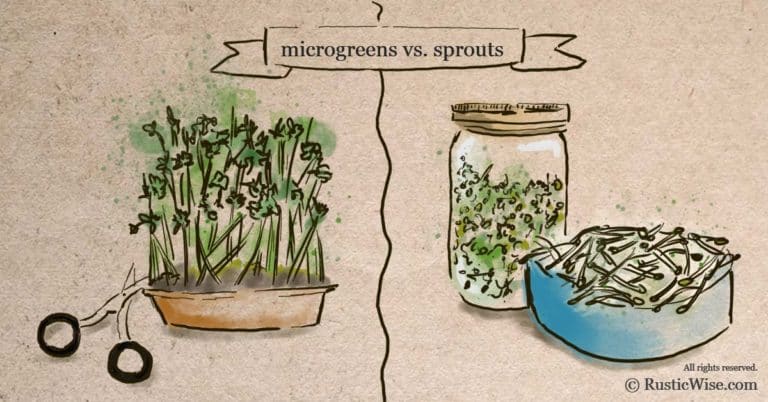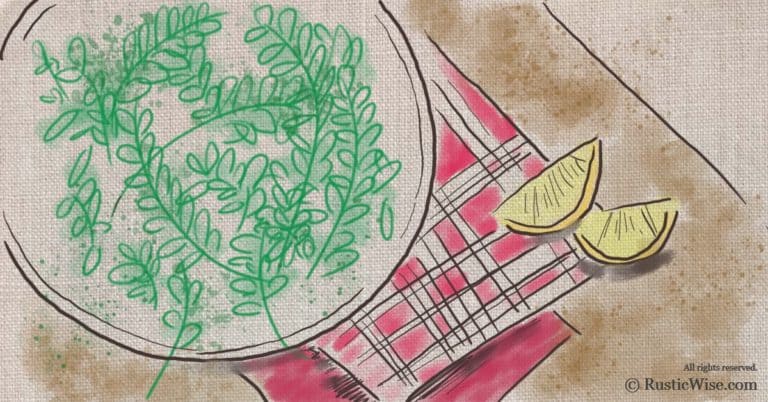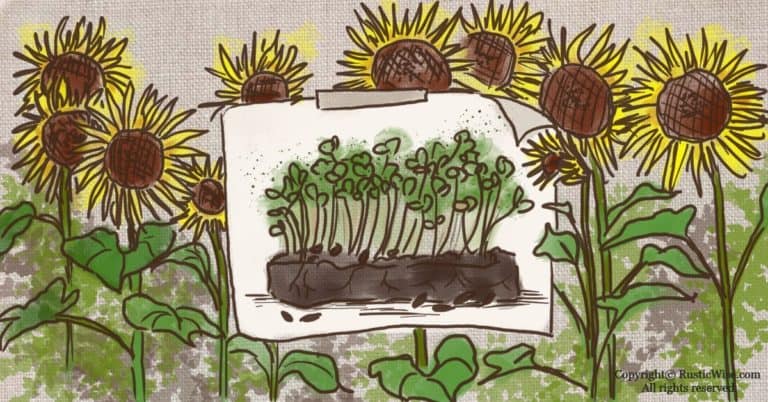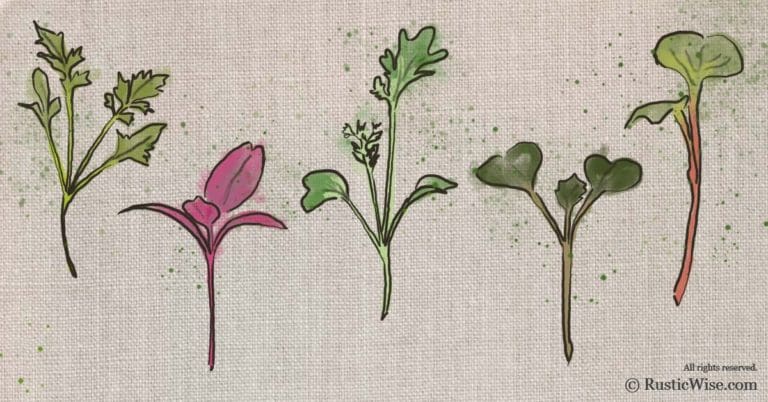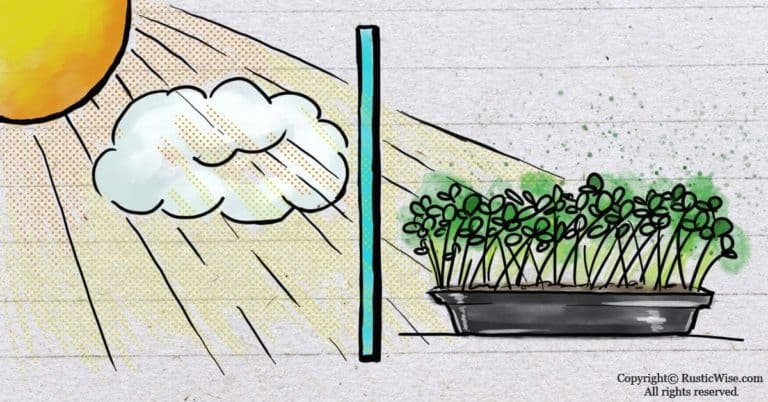Want the Best Trays for Microgreens? 4 Key Things To Look For
RusticWise is supported by its readers. When you purchase through links on our site, we may earn an affiliate commission. As an Amazon Associate, we earn from qualifying purchases. Thank You!
Microgreens open up a world of beautiful, homegrown greens available to anyone with a bit of counter space and sunlight. If you’re interested in sustainability and healthy living, all you’ll need are a few simple supplies to get started.
If you’re new to growing microgreens, you may wonder about the best trays for microgreens. I’ve rounded up 4 key factors to look for in quality trays: shallow depth, good drainage, food safe material, and durability.
Read on for more information on some of the best microgreens trays on the market, plus the different types of trays, and sizes available.
Why regular plant pots won’t do
If you’re wondering whether forking out for new gardening supplies is really necessary when you have stacks of gardening pots at home, here’s why you should get the proper trays.
Unlike regular vegetables or herbs that grow well in containers with plenty of room for deeper roots, microgreens require little depth. Harvested when only between 1 and 3 inches (3 to 8 centimeters) tall on average, these tiny greens also have tiny roots.
So save your garden planters for full-sized crops instead.
While you technically could grow microgreens in any container, growing them in regular garden pots would be a colossal waste of soil. This is especially true if you plan on doing this regularly!
Micros are some of the most rapidly growing and nutritious greens in the world, and they can be grown indoors all year round. So, give those miniature seedlings the best start by providing them with a solid microgreens growing tray.
You might like
Bootstrap Farmer Microgreen 1020 Trays with Holes
- Durable, BPA-free plastic trays with holes. Will last you many years.
- Shallow 1020s are 1.25″ making it easy to harvest your microgreens while using less soil and media.
- Made of recyclable Polypropylene (PP #5) leach resistant plastic with no harmful additives.
Found on Amazon
Check Current Price
Those in Canada and the UK should be taken to the product listing in your region.
Types of trays and lids for growing microgreens
When looking for the right tray for growing your microgreens, there are a variety of options you can choose from. At the very least, you’ll need a shallow vessel with drainage holes to germinate seeds, plus a bottom tray to catch water drainage.
The basic setup goes like this:
- Grow tray: A microgreens growing tray is basically a shallow tray with holes that is designed to hold the growing medium and microgreen seeds.
- Bottom tray: Sometimes called the watering tray, this is a tray without holes that sits below the top microgreens tray. You can use it to bottom water your micros, and catch excess water.
- Covers or lids: During the blackout stage of growth, many growers place lids to block out light. Many growers use an extra bottom tray as a lid by inverting it. Some simply use a piece of cardboard or newspaper to cover the seeds and place it somewhere dark.
- Humidity domes: While not always necessary (depending on the types of microgreens you’re growing and your growing conditions), a clear plastic dome helps retain heat and moisture. It creates a mini greenhouse effect which can be especially helpful if you live in a cool or dry climate.
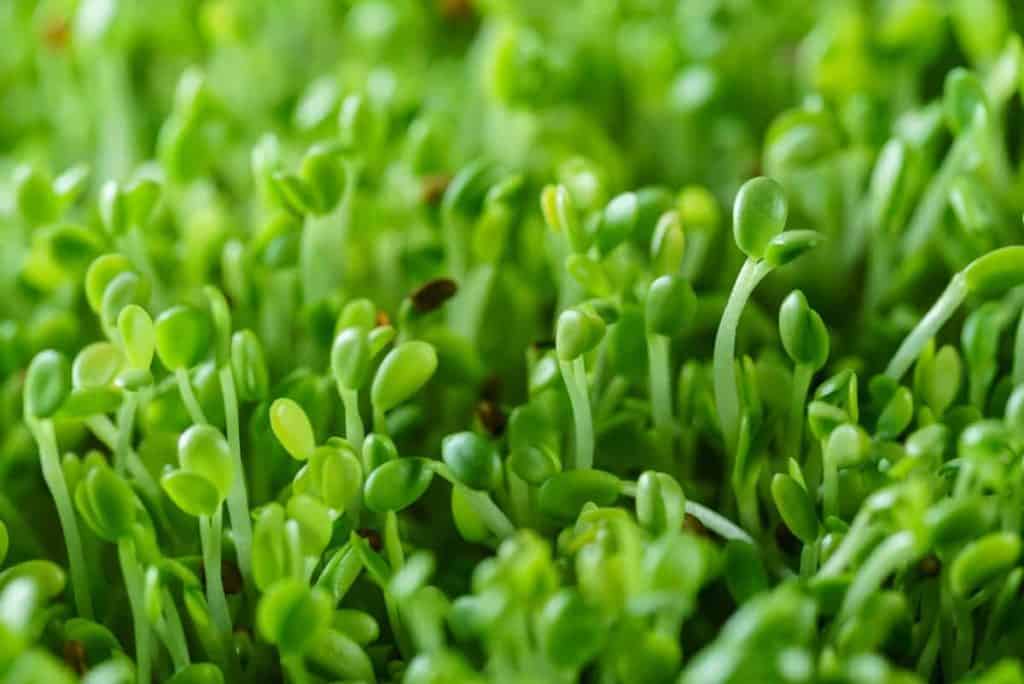
You might like
10″ x 10″ Handy Pantry Microgreen Growing Trays with Drain Holes (10-Pack)
- Made of durable, resuable, and recyclable plastic. Each tray has drain holes.
- 11″ x 11″ top (mouth) of tray – 10″ x 10″ bottom (base) of tray – 2″ deep.
- Two of these trays nest perfectly inside a 10×20 drip tray.
Found on Amazon
Check Current Price
Those in Canada and the UK should be taken to the product listing in your region.
3 Common sizes of microgreens trays
There are three common and standard sizes of containers that come with or without holes:
- 1020 (10 X 20 inches): This is the size of container that most commercial microgreens growers use. It’s a nice rectangle shape that fits nicely on grow shelves or racks. Many home growers who are short on space may find this size too large. But, a 1020 tray without holes is a great all-purpose container that can double as a bottom tray or lid, even if you choose to use smaller grow containers.
- 1010 (10 X 10 inches): This nice square is the “Goldilocks” option for those that want something in between—not too big, not too small. Two 1010s fit snugly in a 1020.
- 5 X 5 inches: Suitable for those who have little space, or those who like to grow many different types of seeds at once. You can fit eight of these beauties in a 1020 tray.
The takeaway: You really can’t go wrong with any of these three options. You’ll have to buy a few different sizes and figure out a configuration that best suits your lifestyle and space requirements. You might want to buy at least two 1020 containers without holes to serve as bottom vessels and buy several 1010s or 5 X 5s with holes to sow seeds in.
You might like
Vented Humidity Dome 5″ Tall Extra Strength for 1020 Tray
- Perfect fit for heavy duty 1020 trays and flats.
- Heavy duty dome is 6″ tall (5.5″ interior space).
- Adjustable humidity vent and easy to grip handle.
Found on Amazon
Check Current Price
Those in Canada and the UK should be taken to the product listing in your region.
4 key factors to look for in the best trays for microgreens
If you’re planning on growing microgreens on the regular, then it’s a good idea to invest in some quality trays. There are a lot of factors to consider, and we’re here to help you make a decision about the best choices for you.
Here are 4 important things to look for in a good tray:
1. Shallow depth
As we touched on earlier, shallowness (in this case) is a good thing.
When growing micros, you only need to use 2 inches of soil max, so a shorter container is ideal. Many containers designed for micros have a depth of less than 2 inches. This prevents soil wastage.
Shallow trays also make it easier to harvest (you don’t need to reach down into the tray to cut near the soil line). Not only is harvesting micros in deep containers awkward, it results in a messier cut.
And finally, shallow vessels allow for good air circulation. If you have fans set up, airflow is better able to move around the soil, stems, and leaves of micros in short trays.
2. Drainage holes
The tray that you’re germinating seeds in should have drainage, as mentioned earlier.
Some people would argue that they can grow great micros in containers without any drainage holes. These people have mastered the art of knowing exactly how much water to use. I do not count myself in this elite group of gardeners and must use trays with holes.
Besides, holes allow you to bottom water your micros, which is great for healthy growth.
Bottom watering promotes strong and vibrant root development by encouraging downward growth. This method of watering also comes with the added benefit of less soil backsplash (if you’re using soil or a soilless medium).
Get some trays with drainage and some without. The ones without are great for using as holding trays (sometimes called watering trays) to catch excess water. They’re also good if you prefer to use grow mats.
Also look for even spacing of drainage holes. The holes should be evenly distributed along the bottom of the tray for good drainage and water intake. Holes should not be so large that your growing medium is falling out.
3. Sturdy and durable
The best trays are those made of strong materials designed to last.
There’s nothing worse than a flimsy tray that bends or warps when you pick it up. And the last thing you want is a tray that develops a crack after only a single use.
Many poor quality materials are thinner, and will become brittle and are prone to cracking when exposed to the sun.
It’s worth it to invest in a few high quality growing vessels that will last many growth cycles.
4. Food-safe materials
It goes without saying that any container you use to grow your food in should be at least food-grade.
Since most vessels are made of plastic, this means looking for materials that are BPA free (Bisphenol A).
They make most quality trays of recyclable polypropylene plastic (PP #5).
BPA is a type of chemical that has been in use since the 1950s. It’s commonly used in some epoxy resins and types of polycarbonate plastics. You can find many cans and bottles lined with epoxy resins containing BPA.
While the U.S. Food and Drug Administration still allows for low levels of BPA in some food packaging, some research links BPA to health concerns.
According to the Mayo Clinic, some research shows that BPA can leach into food from food packaging. This has led to, “concern because of the possible health effects on the brain and prostate gland of fetuses, infants and children. It can also affect children’s behavior. Additional research suggests a possible link between BPA and increased blood pressure, type 2 diabetes and cardiovascular disease.”¹
How do you know if something contains BPA? Check the bottom of your container. The FDA says that resin code 7 indicates that some BPA may be present.²
BPA-free plastics provide peace of mind knowing that the micros you grow will be safe to eat.
You might like
Microgreen Soilless Hydroponics Grow Tray with Cover
- Kit includes: 2 sets of trays, 300 mL spray bottle and 20 sheets growing paper.
- Made from food grade (BPA-free) plastic. Two sizes of netting for small and large seeds.
Found on Amazon
Check Current Price
Those in Canada and the UK should be taken to the product listing in your region.
A note about repurposing containers
If you’re just starting out with growing microgreens, many people turn to repurposing containers you already have at home. There’s no shame in this!
We have an entire article about Ways to Repurpose Containers for Microgreens.
One of the most common containers people reuse is plastic clamshell containers. The pint or half-pint sizes have an ideal depth. Pint containers typically hold blueberries, or cherry tomatoes. Half-pint clamshells contain blackberries and raspberries.
Tip: Many repurposed containers like clamshells are flimsy. To strengthen them, double them up!
So, what’s the best tray for microgreens?
There really is no “best” tray that suits all. It really depends on what suits your space, preferences, and budget.
Many growers rave about Bootstrap Farmer trays, which all receive glowing reviews. These are a bit pricier, but their trays are built to last.
Containers from True Leaf Market are also popular and a bit more affordable. Handy Pantry is a supplier to True Leaf Market, and you can find many of their products online.
Plus, you really can’t ignore Amazon. While there are definitely some subpar products to sift through, but just look for the 4 key factors outline above, and you really can’t go wrong.
Related questions
Does a microgreen container really need drainage?
Yes, microgreens trays should have drainage holes to prevent overwatering. And the best way to make sure your microgreens don’t get overwatered is to make sure they have proper drainage via a porous soil or growing medium, plus vents or holes at the bottom.
Without drainage holes, water can build up in the container, which is a problem because microgreens don’t like to be soaked. This leads to issues such as mold or fungal growth, root rot, and other headaches that could easily be avoided with proper drainage.
Why are most grow trays black?
The large majority of grow trays you find on the market are black. I’m assuming this is for several reasons. One is that black helps block out light. When seeds are in the germination phase, they don’t need light.
(I’ve seen some transparent or white micro containers available online, and I personally wouldn’t choose these over black ones.)
Second, black attracts heat, and seeds require warmth in order to germinate.
👉 If you like this post, see our Complete Guide to Growing Microgreens at Home. 🌱
Would you like more timeless tips via email?
Fun tips to help you live an independent, self-sustaining lifestyle. Opt-out at any time.


References
- Mayo Clinic, What is BPA, and what are the concerns about BPA?, https://www.mayoclinic.org/healthy-lifestyle/nutrition-and-healthy-eating/expert-answers/bpa/faq-20058331. Accessed December 2022.
- U.S. Food & Drug Administration (FDA), Questions & Answers on Bisphenol A (BPA) Use in Food Contact Applications, https://www.fda.gov/food/food-additives-petitions/questions-answers-bisphenol-bpa-use-food-contact-applications. Accessed December 2022.

Author: Josh Tesolin
Josh is co-founder of RusticWise. When he’s not tinkering in the garden, or fixing something around the house, you can find him working on a vast array of random side projects.

